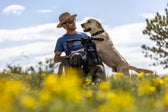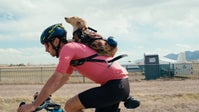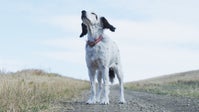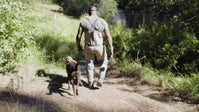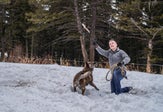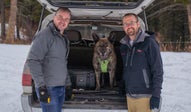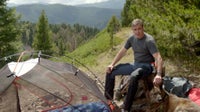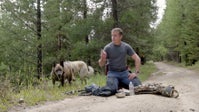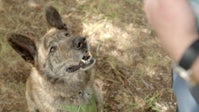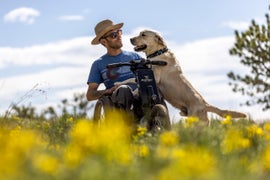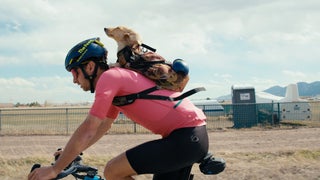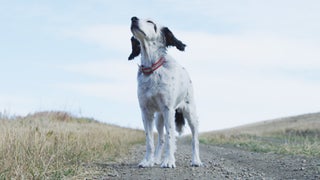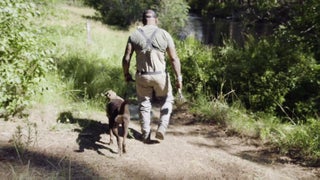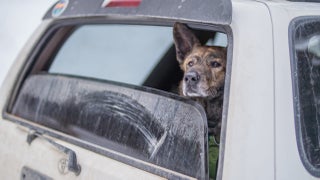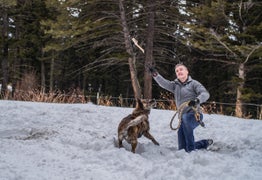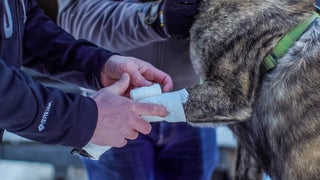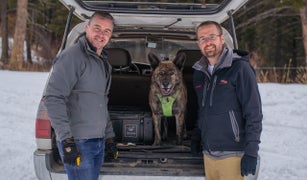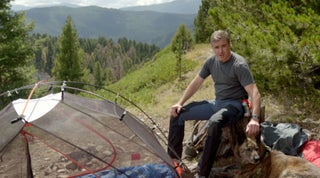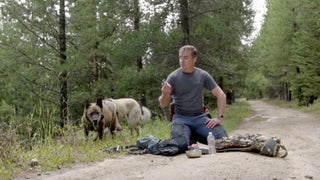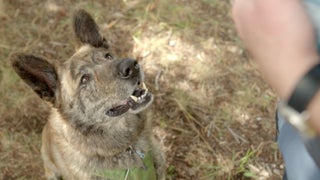WES SILER: So I've got this harebrained theory, and I want to bounce it off you because I'm just a normal person and you're a vet. So when you think about human injuries in sports, it's people who are sedentary during the week and then try to too hard on Saturday. Does the same thing exist for dogs?
JOE SPOO: Absolutely. I'd say it's the most common thing is that exact scenario. A dog sits around all week, no exercise, and then we ask it to be an ironman athlete on the weekend, and unfortunately, or fortunately, a lot of dogs are able to do that. But there's a lot of dogs that aren't, and that's where a lot of the injuries we see, or even worse is the person that has that dog sit around for months and then go and do some great, big adventure.
WES SILER: Right.
[MUSIC PLAYING]
[HOWLS]
And so what I try to do to injury proof my dogs is I try to give them a good amount of daily exercise, and it can't always be hours. It might just be 30 minutes or an hour. But I try to make sure they have that everyday of off-leash running, and then I try to make that terrain as challenging as possible. So they're falling and jumping and running, and I think that sort of builds muscle, makes bones denser, improves the health of ligaments, and obviously the physical fitness just of running every day, as well. Is that also injury proofing my dogs?
JOE SPOO: Absolutely. And I think, to kind of expand on that a little bit, the big thing would be that person who does that every day, but it's in the dog park on grass, and so we're not toughening those pads up or doing varying terrain. And so I would say, a couple of the days, if we could maybe go out on a gravel road so that we have that rocky environment or if we could find a sandy area where those claws are going to have to sink a little bit so we can avoid nail bed. And so thinking about kind of playing to the scenario, if hiking in the mountains is your goal, then we need to toughen those pads up-- and so making sure that during the week activity is doing that.
The other thing, to your point, unlike the bone density and the joints and ligaments, is if we don't have a varied terrain-- so we can't do hill work with these dogs or jump off of things-- is to create those scenarios, right? And so what we can do is short retrieves-- and so, like, 20 or 30 yards-- because we don't want that dog to get a full head of steam. So it's not taking the Chuckit and whipping that ball 100 yards. It's that short where the dog's having to get a burst of speed, not up to full speed, and then stopping so that we're pounding on those joints.
WES SILER: So it's a wind sprint with a stop and turn at the end, and you're making that as hard as possible and repetitive as possible every day.
JOE SPOO: Exactly. And so for so long in dogs we've thought about just go and do a big activity, when actually, if we kind of make it like human performance, doing interval work, doing the long, slow distance, kind of building--
WES SILER: A deliberate workout.
JOE SPOO: Exactly, and I think most people don't do that. Because these dogs are amazing creatures, we think they can just go and do these things. But they need the same sort of conditioning and athletic kind of improvement that we do. And I equate it to when I used to run marathons. My training runs were 26 miles. They were much shorter. I did a lot of track work and things like that. Same thing with these guys. You know, you're not going to go and hike for multiple hours every day, but we can condition the body, to your point, to get to that point.
WES SILER: Right. And so for me, the big, exciting trips I do with my dogs are multi-day backpacking trips, three to seven days long, which means we could be anywhere from 1 and 1/2 to four days away from the car. And you don't want to get an injury four days from the car with an 85-pound dog and have to carry it out. And so am I helping to ensure that I don't have to do that by exposing my dogs to similar environments in this sort of deliberate training schedule.
JOE SPOO: Yes, very much. And I think, kind of like we've talked, it's that daily conditioning so that they don't fall out of condition and then, potentially on the weekends, you're doing more kind of real-world activity. So those are like your long runs, right? So maybe you go for a six to eight-hour hike on a weekend, but you're close. You can get back to the car quickly if need be, and those are kind of that training run kind of test runs for, are we going to be OK when we get multiple days back into the back country?
WES SILER: Gotcha. So you want to look and show us what a short retrieve looks like with Wiley right now?
JOE SPOO: Sure.
WES SILER: So we can just-- we don't want to throw it super far. We just want to create a repetitive, short distance. You want a stick? You want a stick? You want a stick? You want a stick? You want a stick? Get it! Just like that kind of thing?
JOE SPOO: Yeah, and maybe just a little bit further.
WES SILER: OK.
JOE SPOO: And so the big thing is he gets that explosive start and the quicker stop.
WES SILER: Gotcha. So like that?
JOE SPOO: Perfect.
WES SILER: Yeah, and then he has to break into it, and he's turning.
JOE SPOO: Yeah, so you can see how he kind of pounded those front feet as he was stopping.
WES SILER: Gotcha.
JOE SPOO: But he didn't work up to full speed.
WES SILER: Gotcha.
JOE SPOO: It's building that up so that his nail beds digging in, his wrists, all those sort of tissues are being worked, but not to the extreme.
WES SILER: And so we're literally doing sets of those.
JOE SPOO: Exactly.
WES SILER: You know, like-- yeah.
JOE SPOO: Yup, so you're doing some reps of those as part of your-- so maybe to your half-hour workout, maybe you start with those, and then you go on a free run, and you end with those. And then we've had a couple of different type of workouts in your 30-minute workout.
WES SILER: Yeah, and so he's gotten those impacts, and he's gotten that paw work and that nail work and everything else and he's--
JOE SPOO: Exactly.
WES SILER: Yeah, he's building that muscle, building bone density, and strengthening his leg muscles.
JOE SPOO: Exactly.
WES SILER: Gotcha. Awesome. Cool. You want to go for a hike, Wiley? You got your stick? Let's go. You forgot your stick.
